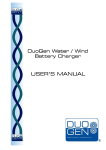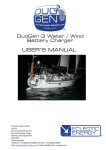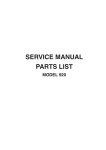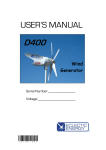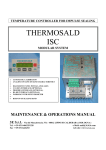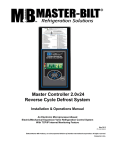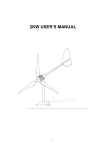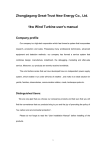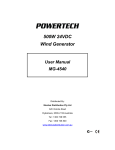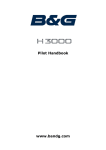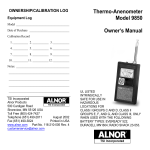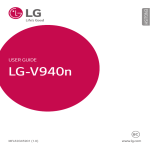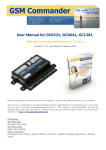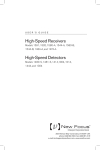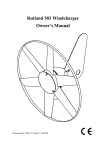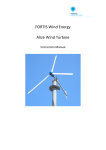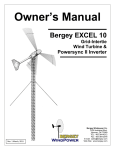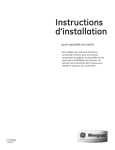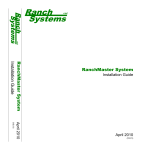Download USER`S MANUAL
Transcript
DuoGen-2 Water / Wind Battery Charger USER’S MANUAL The Physics of Wind Generation The power output from any wind turbine is largely dependent on two factors, the prevailing wind speed and the swept area of the rotor. This intercept area is governed by the length of the air blades - the longer they are, the greater the potential power of the wind generator. Unfortunately, it is not practical to fit large wind turbines on yachts, and machines with rotor diameters of around 1 metre are the norm. The amount of energy available in a wind stream varies as the cube of its velocity - for example, there is over 70% more energy available at 12mph than at 10mph. Very low windspeeds contain very little energy, so although a wind turbine may spin, it will produce little or no power. With increasing wind speed output from the turbine rises exponentially. Wind is a variable but occasionally very powerful resource, and sensible sailors tend to avoid its worst excesses. Where possible, sailors will sail downwind and anchor in sheltered spots, all of which reduces the energy available to a yacht-mounted wind generator. Given these constraints, a wind generator is unlikely to keep pace with all electricity usage on a daily basis. It can, however, make a very useful contribution to the energy budget. Please note: some of the illustrations in this manual are of the original DuoGen model, but the instructions apply to DuoGen-2. The DuoGen is different. By deploying the water mode when you go cruising: The DuoGen taps into the wind power that the yacht’s whole sail area intercepts This is many times greater than that of a yacht-sized turbine At typical cruising speeds, the DuoGen in water mode produces enough power to run most if not all of the yacht’s electrics The DuoGen’s water mode is much more efficient than a wind generator at sea and much easier to live with. Welcome to DuoGen Congratulations on your purchase of the DuoGen water/wind battery charging system for yachts. CONTENTS The physics of Wind Generation DuoGen has been especially designed and precision manufactured to provide the most practical and user-friendly system currently available for renewable energy electricity generation on cruising yachts. DuoGen is a combined water and wind generator that can be easily reconfigured to harness the kinetic energy in either a wind stream or a water stream in order to produce electricity. DuoGen has been specifically designed for use aboard cruising yachts where the wind mode is operated in harbour or at anchor, and the water mode is deployed when the yacht is under way or at anchor in flowing water. The benefit of this dual mode system is that the owner has greater potential for energy conversion than is possible with a single source system. This is because the air stream intercepted by a yacht’s sails when it is under way is many times the area intercepted by a typical wind turbine. In a given wind speed, therefore, the amount of battery charging power produced is usually far greater when a yacht is under sail and a water generator is deployed. Welcome to DuoGen 1 Mounting options 2 Installing DuoGen 2 DuoGen in wind mode 3 Wind mode outputs 3 DuoGen in water mode 4 Water mode outputs 4 Adjusting the diving plane 4 Drag 4 Drag performance comparison 4 Electrical Connection (with circuit diagrams) 5/6 Using a battery monitor 5 Deploying DuoGen in wind mode 7/8/9 The upper tower clamp Self-furling 8 10 Deploying DuoGen in DuoGen brings the benefits of dual mode operation to the yacht owner in a truly practical form. The change from water to wind mode is accomplished in seconds without the use of tools and without having to demount and reposition major system elements or electrical connections. When using your DuoGen, always exercise due care and operate the equipment in accordance with the manufacturer’s recommendations contained in this manual. DuoGen should then deliver years of trouble free service. This instruction manual contains important safety information which will enable you to get the most from your DuoGen. Please read this manual thoroughly prior to the installation and operation of the equipment. 1 water mode 11/12/13/14 Maintenance and repairs 15 Spare parts list 15 Contact details 15 Regulation 16 Commissioning 17 System Monitoring 17 Performance and Expectations 18 Guarantee 19 Certificate of conformity 19 Your notes 19 Installing DuoGen The DuoGen is supplied complete with a universal mount kit. This hardware has been designed to offer flexibility of mount options. In most cases, the universal mount bracket is simply clamped to the existing pushpit rail and the swivel foot at the bracket’s base is through-bolted to the coaming or transom. Once in place, the universal bracket provides the upper and lower mount points for the DuoGen. Of course, yachts vary widely in size and form. In some cases, such as canoe stern yachts or yachts with extended bathing platforms, some additional bracketry may be required. Eclectic Energy has lots of experience of installing DuoGens, and can offer offer advice and suggestions for achieving the best installation - a photograph or drawing with some key dimensions such as freeboard and rail height & diameter will help us advise you. The DuoGen should be placed either on or as close to the yacht’s centre line as possible. This minimises the effects of heeling on the running depth of the water mode. However, in practice, if the mounting is within 800 - 900mm of the yacht’s centre line, the DuoGen will perform well. Once the DuoGen has been installed all subsequent operations and mode changes are accomplished without the need for tools. For information on achieving an optimal mounting on your yacht, refer to the dimensioned mounting schematic provided together with the installation instructions. DuoGen is supplied complete and ready to install. There may, however, be additional items you will need to incorporate in order to optimise the installation. Mounting Options Now is the time to order: waterproof deck gland regulator charge splitter battery monitor etc See Parts list on Page 15 2 DuoGen in Wind Mode Wind Turbine Air blade Transmission now contains gear set and sealed bearings. Air hub Turbine securing pin Drive shaft securing pin Drive shaft Recovery lanyard shackle Yaw arm - now manufactured from rotationally moulded polyethylene plastic Yaw arm release plunger Tower Pushpit clamps This part has been replaced with a thumbscrew. Clamp shaft Upper tower clamp Alternator mount pins ‘C’ bracket Alternator Alternator yoke 3 The DuoGen has been carefully designed to be as safe as possible in operation. However, all rotating machinery is potentially hazardous. In consequence, the equipment should be operated in accordance with the manufacturer's instructions at all times. DuoGen in Water Mode Adjusting the diving plane The angle of attack of the DuoGen’s diving plane is adjustable by a few degrees either side of 0º or hydrodynamic neutral. The neutral point is found by aligning the mark on the diving plane and water impeller bracket. 0º should prove suitable in most cases. Adjusting the diving plane in the minus direction will cause the impeller to run nearer the surface and adjusting in the positive direction will cause it to run deeper. To adjust, slacken the M8 pivot bolt, and loosen the socket cap lock screw below it. Re-position the dive plane and re-tighten the M8 pivot bolt. Finally, re-tighten the socket cap screw to lock the dive plane securely in the new position. The DuoGen's water mode is generally benign in operation, but care should be taken when deploying the unit that no swimmers or other obstructions are in the water beneath it. Ensure that the bolt and lock nut are tightened firmly. Yaw arm lock hole Water bracket Water impeller and transmission Drag: DuoGen’s water mode operates in the top 1/2 metre of water, within the same wave as the yacht. Amp for amp,drag from the impeller unit is 30 % lower than that of other towed units. Diving plane 4 Electrical Connections Wiring diagram showing twin battery bank system with charge splitting regulator and independent metering. Where a battery monitor is fitted Connect the output cable to the battery bank(s) using the suggested wiring diagrams for guidance. Remember to observe the correct polarity. RED to POSITIVE + and BLACK to NEGATIVE – The DuoGen alternator is fitted with 2 metres of 4.5 sq. mm. cable. Use cable of at least this cross -section to connect from the lazarette area to the batteries. An in-line fuse is supplied, rated at 40 amps for a 12 volt machine and 20 amps for a 24 volt machine. It is important that a fuse is fitted close to each battery bank. 5 If your yacht is fitted with a digital battery monitor, it will be driven from a shunt installed close to the batteries. Shunts are typically about 100mm long, consisting of a brass bar with a terminal post at each end. One side of the shunt is connected directly to the battery terminal. All other connections are made to the opposite side of the shunt, which may be connected to a busbar. The shunt is most usually connected in the negative line. When wiring the DuoGen to a system fitted with a shunt, observe polarity and connect the appropriate DuoGen output cable to the non-battery side of the shunt. Again observing polarity, the other DuoGen output cable should be made directly to the battery terminal or associated busbar. The DuoGen’s output will now pass through the shunt and the monitor will display a reading. If the shunt is bypassed by connecting both positive and negative output leads directly to the battery, the meter will fail to ‘see’ the DuoGen, and register no output. Note that where a battery regulator is fitted, dumped energy from the DuoGen will not be seen by the battery monitor. Electrical Connections Wiring diagram showing single battery bank with regulator We recommend that the DuoGen is permanently hard-wired. The cable should enter the yacht via a deck gland and connection made to the battery wiring using a waterproof junction box. The DuoGen must always be connected to a battery when in use, otherwise a dangerously high voltage can be generated at the output cable. Wiring diagram showing single battery bank without regulator The use of deck plugs and sockets is not recommended. These can become accidently unplugged, and the plug pins then constitute a shock hazard. If in doubt, refer to a competent electrical engineer or the manufacturers. 6 Deploying DuoGen in Wind Mode To assemble the wind turbine: we recommend that you kneel and work on a firm surface, such as the cockpit floor - this not only makes the operation easy, but also makes it very unlikely you will drop any components overboard! slide the key on one blade root into the keyway on the next blade continue in this way until you have assembled four blades with the assembly resting on the floor with the gap uppermost, position and slide the fifth blade into place the air drive hub features concentrically arranged conical pins identify the matching conical recess in the turbine blade assembly offer the turbine hub up to that side, aligning the pins with the recesses to complete the assembly, screw the clamping plate onto the hub and tighten firmly Spring pawls are fitted in the clamp plate to prevent vibration from loosening it, and you will hear these clicking as you tighten the clamp plate. Use only firm hand pressure to tighten the clamp plate. The spring pawls are factory set and secured with a threadlocking compound. Do not attempt to adjust these in any way. visually check that both hub and clamp plate are firmly seated on the blade roots - there should be no gaps or movement evident in the completed assembly Care should be taken when dismantling and re-assembling the air turbine rotor, as, for maximum aerodynamic efficiency, the blades feature fine trailing edges which can cause injury if not handled with caution. Before attaching the air drive to the yaw arm : check that the upper tower clamp is securely closed and that the locking pin is in place (see box right and pictures on Page 8) check that the alternator yoke is locked centrally by tightening the thumbscrew on the ‘c’ bracket orientate the yaw arm so that you will be fitting the turbine downwind, and ensure that it remains downwind throughout the operation 7 The upper tower clamp holds the machine in a vertical position when operating in wind mode. The clamp features a two stage locking mechanism in order to prevent accidental release when the machine is running. It is essential to ensure that this clamp is secure. The clamp is closed by swinging the hinged retaining bar across the clamp such that it engages in the gate opposite the hinge. The knurled thumb nut is then tightened until the DuoGen’s tower is gripped firmly by the clamp. Finally, the safety locking pin is inserted which prevents the thumb nut from becoming loose due to vibration. Note, when fitting the locking pin, its lanyard should pass around the tower as this acts as an additional failsafe. NB: If difficulty is experienced when trying to close the clamp, ensure that it is correctly aligned and square to the tower tube. Wind mode 2 Operating the upper tower clamp Always lock the upper tower clamp as above before operating in wind mode grip the air drive in one hand, holding a blade with the other to prevent rotation offer the air tenon up to the yaw arm socket align the holes in the yaw arm and the air tenon, and insert the turbine securing pin and lock with a beta pin. once the tenon is located in the socket, tie a short piece of line around the blades and the yaw arm to prevent blade rotation extend the telescopic drive shaft until the conical connector boss mates with the air drive rotate the drive shaft until the holes align and insert the drop nose pin Note that the 5mm stainless steel friction pin which holds the conical connector to the drive shaft can be used as an alignment aid. Simply align the head of the friction pin with the hole in the air or water drive, and the drop nose pin should pass through easily. Securing the drop nose pin Ensure that you rotate the drop nose tab through 90° and push backwards so that it forms a ‘T’ this is the lock position for the pin as the tab is retained by a ball spring. 8 Wind Mode 3 holding an air blade to prevent rotation, remove the lashing on the blades raise the yaw arm to the top of the tower and release the spring plunger by rotating the black knob anti-clockwise note that in wind mode the plunger rests on the top tower bearing rather than being located in the yaw arm lock hole finally, release the air blade and, using the yaw arm handle, turn the turbine into the wind. The turbine will begin to run. NOTE: DuoGen should always be stopped using the moulded yaw arm handle, even where an electrical brake switch is fitted. To stop DuoGen wind mode: grasp the moulded yaw arm handle and turn the machine gently through 180º the turbine will slow down and stop as soon as it stops, grip a turbine blade to prevent rotation (the blades will run backwards down wind!) release the spring plunger and lower the yaw arm Air blades secure the blades with a lashing of light line Never be tempted to hold the turbine by the air drive tenon and let it run in the wind. This is highly dangerous. The turbine will accelerate very rapidly, and the forces generated will become unpredictable and difficult to control, due to the gyroscopic effects. 9 In wind mode, as with all wind turbines, the major hazard lies in accidental contact with the turbine blades. Although the DuoGen's blades run more slowly than many competitor machines, they are still capable of inflicting injury. When correctly installed and operating, the DuoGen's air blades are safely above head height. By using the handle on the machine's yaw arm, DuoGen can quickly be stopped even in severe conditions, without any risk of injury from the blades. Furling in Wind mode The DuoGen’s wind mode incorporates self-furling. This can be viewed as analogous to a yacht heeling to gusts of wind. In light breezes, the DuoGen’s air rotor will point almost directly at the wind. As the wind speed increases, it will begin to furl about the main tower pointing progressively off the wind. Once a gust has passed, the air rotor will move back more closely to the wind direction. The effect of this furling action is to progressively reduce the intercept area of the air rotor in response to rising wind speeds, in much the same way that heeling reduces effective sail area on the yacht. High electrical outputs are maintained, but the wind loading on the DuoGen, its mounting and ultimately the yacht’s moorings, are controlled. In moderate breezes, the rotor may sit 5º to 10º off the wind, and in high winds 20º to 30º. In practice, you will observe the DuoGen furling gently as a heavy gust of wind strikes, and then return to its original position as the gust passes. The furling force is provided by the alternator’s reluctance to be accelerated. This furling force is balanced by the wind loading on the air turbine rotor, and the DuoGen’s yaw arm, which acts like a tail. In certain conditions, excessive or erratic furling may be observed. Probable causes are: a) the operation of the regulator - as the regulator starts to dump power, the alternator suddenly becomes ‘stiffer’ to turn and this produces a large increase in the furling force. b) turbulent air - as the furling force is balanced primarily by the wind loading on the rotor disc, turbulence and sudden ‘holes’ in the wind can result in an excessive and erratic furling action. Such turbulence is usually caused by obstructions upwind or down wind of the turbine, and are particular to a certain location and wind direction. c) mechanical or electrical fault - usually indicated by low or no electrical output, and/or undue mechanical friction and noise. d) stiffness in the yaw bearing - usually caused by dirt or salt on the bearing surfaces. The yaw bearings are of a dry running plastic type, designed to run on anodised aluminium. Periodic flushing with fresh water and polishing the tower tube with a silicone-based furniture polish should restore free movement. When lying at anchor with the wind mode deployed, the furling action can be disabled by inserting the yaw arm spring plunger in the 10mm hole at the top of the main tower. This locks the yaw arm with the air rotor facing directly towards the bows. The yacht herself now keeps the air rotor pointing at the wind, and power outputs for a given wind speed will generally be higher. A similar effect can be achieved by restraining the yaw arm with shock cord or a lashing. We recommend that you restore the furling action if the wind speed exceeds 25 knots or if you leave the boat. 10 Deploying DuoGen in Water Mode release the yaw arm spring plunger and lower the yaw arm to stop insert the water bracket tenon into the rear of the mounting socket on the yaw arm secure with a pin and a beta clip extend the drive shaft until the connector boss mates with the impeller transmission rotate the drive shaft until holes align and insert the drop nose pin The DuoGen's water mode pivots in two planes at the alternator mounting to allow for manoeuvring the yacht and for wave action. In common with other water generators, this hinging creates a potential trap hazard for hands and fingers. The DuoGen is designed with generous clearances to minimise the risk of accidental crush injuries. Nevertheless, handling the alternator and its mounting yoke when the water mode is deployed should be avoided. attach the recovery lanyard to the shackle on the yaw arm form a loop on the inboard end and drop it over the hook on the upper tower clamp adjust the length of the lanyard such that it holds the DuoGen clear of any part of the yacht’s structure (ie. steering system servo oars) when the yacht is stationary the lanyard should hang loose when the yacht is underway and the DuoGen is operating normally 11 DON’T PUT YOUR HANDS HERE! Water Mode 2 To deploy in water mode: raise the yaw arm to the top of the tower. You must ensure that the spring plunger is located in the locking hole at the top of the tower. This prevents the yaw arm from rotating around the tower and ‘capsizing’ the water impeller when underway to locate the locking mechanism, align the etched marks on the yaw arm with the top of the main tower. release the spring plunger by rotating the black ball knob anticlockwise (downwards), and move the yaw arm gently side to side until the spring plunger clicks into the lock hole remove the upper tower clamp locking pin and unscrew the thumb nut on the retaining bar and pivot it clear of the tower holding the recovery lanyard, push DuoGen backwards freeing the tower from the tower clamp. the unit can now be gently lowered into the water using the recovery lanyard Running in Water Mode DuoGen’s alternator yoke allows freedom of movement in two planes so that wave and helm action can be accommodated. WARNING: the DuoGen should never be allowed to operate if it is not connected to a battery. This condition allows the machine to overspeed and very high voltages can be produced. NOTE: Although you can motor slowly astern with the DuoGen deployed,we recommend that it is not deployed until the yacht is moving slowly ahead. Due to its closed cell foam filling the yaw arm is naturally buoyant. However, if the yacht is stationary and a sea is running, the relative movement of the yacht and the DuoGen can cause the tower to bump against the transom of yachts with retrousse sterns. To avoid this, tie a loop in the recovery lanyard and drop it over the hook incorporated in the upper tower clamp assembly. Adjust the length of the line such that it becomes taut just before the DuoGen’s tower contacts the yacht’s transom. Note that using the recovery lanyard to limit downwards travel of the DuoGen is very important, particularly when the unit is installed on a multihull. Catamaran hulls can ‘bridge’ a wave and trough, allowing an unrestained DuoGen to fall almost to the vertical. Once in this position, the horizontal pivot at the ‘c’ bracket can no longer effectively dissipate side forces, and damage to the yoke and alternator casting may result. In normal operation when the yacht is underway, the recovery line will hang loose, as the DuoGen rides on its diving plane at an angle of 35 - 40º to the water surface. Having deployed the DuoGen water mode, ensure that you release the alternator yoke by unscrewing the black thumbscrew on the ‘c’ bracket. This allows the alternator yoke to pivot laterally. 12 Water Mode 3 A clearing line can be utilised if clogging of the impeller is a problem. This is best accomplished with the piece of 3mm prestretched line supplied, secured by a stopper knot through the hole in the diving plane, and the other end made fast to the shackle above the moulded handle recess in the yaw arm. Alternatively, the clearing lines can be secured to a loop of line attached to one of the holes in the alternator backplate fin. This option allows the clearing line to be used to assist recovery of the DuoGen without reducing boat speed. Refer to section on ‘Recovering water mode’ overleaf. Two additional holes are provided at the tips of the diving plane and further lines can be passed through these and secured in a similar manner to provide even more protection against floating debris. Recovering the DuoGen from Water Mode To recover the DuoGen from water mode with the yacht stopped or moving slow ahead: centralise the alternator yoke and tighten the ‘C’ bracket thumbscrew - this will lock the yoke in its central position using the recovery lanyard, pull DuoGen out of the water and back to the vertical clip the tower into the upper tower clamp and re-secure the knurled thumb nut fit the failsafe locking pin, looping the lanyard around the tower for extra security (see page 10) pull the black knob which actuates the spring plunger rearwards and rotate anti-clockwise to lock the yaw arm can now be lowered to its stop withdraw the drop nose pin and disconnect the drive shaft withdraw the turbine securing pin and remove the water turbine assembly from the yaw arm 13 Water Mode 4 To recover the DuoGen from water mode with the yacht underway: The weight of the DuoGen’s alternator helps to balance the weight of the tower , making the DuoGen easy to raise and lower using the recovery lanyard when the yacht is stationary. However, when the yacht is underway, the hydrodynamic force generated by the diving plane, which prevents the water impeller from surfacing, also makes it difficult to raise the DuoGen at boatspeeds over 3 knots. Ensure that electrical connections are secure and permanent. Always fit an in-line fuse Prior to recovering the DuoGen from its water mode, either: Do not use crocodile clips or slow the yacht to 3 knots or less. OR temporary connectors. Use a waterproof gland where the cut the top off a plastic bottle, and allow it to slide down the cable passes into the boat. Use clearing line. This will lodge at the diving plane and break the extension cable which is at least water flow, making the DuoGen easy to raise. OR the same cross-sectional area as the cable supplied with the install a longer recovery lanyard via a small block off the backstay DuoGen, that is 4.5² mm. or other convenient point, such as a davit. The enhanced lead Corroded connections are the angle and purchase this will provide should make single biggest cause of electrical recovery much easier. failures on yachts. It is good practice to smear battery terminals and other exposed connections with petroleum jelly in order to prevent this. Once the DuoGen is installed, it is not necessary to disconnect the electrical connections when The Diving Plane changing mode. The running depth of the DuoGen’s water impeller unit is controlled by the diving plane. The impeller usually operates in the top 500mm of water and 300mm is a typical depth for the impeller hub. The foil can be adjusted to allow the impeller to run a little deeper or shallower if required. Note that the mount height of the alternator also has an effect on running depth, so raising or lowering the pivot point height is an additional or alternative option. The diving plane is adjusted by loosening the M8 a bolt and nut, together with the alan head locking screw immediately below. The foil can be moved several degrees either side of a ‘mean’ indicated by the alignment marks in the casting. Tighten the M8 bolt in the new position and finally toghten the lock screw to secure. Ensure that the cable runs freely and without obstructions. Should the DuoGen be vibrating or unduly noisy in operation, it should be stopped immediately whilst the cause is identified. DuoGen should never be allowed to run with damaged, cracked or misaligned turbine or impeller blades. 14 Repairs and Maintenance SPARE PARTS The DuoGen is designed to require minimal maintenance, but a little attention will pay dividends in terms of appearance and performance. We recommend that you carry the following parts in case of loss or damage: Periodic washing with fresh water will remove accumulated salt deposits and keep the yaw bearings and the telescopic drive shaft sliding smoothly. An occasional application of a domestic siliconebased polish on the tower tube and drive shaft is also recommended. 1 x drop nose pin 2 x air turbine blades 1 x turbine securing pin and The alternator requires no maintenance as it is hermetically sealed, and the bearings are protected by a twin lip radial shaft seal. The water mode is robust and efficient, and maintenance free as the impeller transmission device is lubricated by a combination of synthetic oil within the matrix of the bearing material and water. When dry following immersion in sea water, the unit may feel a little stiff. This is due to dry salt deposits and the unit should free up immediately it is returned to the water. However, the DuoGen’s water impeller rotates about 5 million times for every thousand miles sailed, and like all mechanical devices, is prone to wear. We recommend that the transmission elements are replaced every 8 - 10,000 nautical miles, or 40 - 50 million revolutions, in order to maintain optimum performance. This is a straightforward procedure that can be undertaken by the owner. beta clip (tower pin set) 2 x 40 amp fuses (12 V) OR 2 x 20 amp fuses (24 V) 1 x tower lock pin ‘c’-bracket locking pin set airdrive grease set of water drive bearings (A Spares Pack containing these parts is available) The DuoGen’s air mode transmission device incorporates a heavy duty gear set and thrust bearings, all running behind grease seals. The gear faces benefit from the occasional light application of a good quality weather resistant grease, as supplied. CONTACT DETAILS For after sales service and information, spare parts and repairs, contact Eclectic Energy Limited Unit 22 Sherwood Networkcentre Sherwood Energy Village Ollerton Nottinghamshire United Kingdom NG22 9FD phone: +44 (0)1623 835400 fax: +44 (0)1623 860617 e-mail: [email protected] 15 Regulation The DuoGen is capable of delivering sustained levels of high power. Therefore it is important to ensure that overcharging does not occur. Overcharging is characterised by excessive battery terminal voltages and loss of electrolyte. Permanent battery damage can result. The two main strategies to avoid this are: Manual Monitoring This entails monitoring battery state and simply starting or stopping the DuoGen as required, For owners who live aboard this is a viable option, particularly if the battery bank is of high capacity. Dump Regulation Eclectic Energy Limited or your supplier can supply a dump regulator which is installed close to the batteries. The regulators are factory set at 14.2 (12V) and 28.4 (24V). The regulator is adjustable between 11.5 and 17V. You set the voltage in accordance with the battery manufacturer's recommendations and as this voltage is reached, the regulator progressively diverts the DuoGen’s output to a pair of large wire wound resisters where the excess power is lost as heat. The Pros and Cons of Regulation Eclectic generally recommends that the DuoGen is used in conjunction with a regulator. However it is important to be aware of their limitations. As regulators work by sensing battery terminal voltage, any other device that raises that voltage, such as a solar panel, can cause the regulator to dump power prematurely. For this reason, where possible, a single regulator should be used. The regulator usually supplied with the DuoGen is rated at 40 amps (12V) or 20 amps (24V). As well as the DuoGen, the regulator will also accept the input of up to 150 watts of solar panel. If this is not practical, an alternative solution is to install the regulator with a bypass switch. On passage when you can monitor the system, bypass the regulator and avoid unwanted dumping of power. When you leave the boat, switch it back on. Note that where a bypass switch is fitted, the charge splitting function of the regulator is also bypassed when the switch is activated. We recommend that the bypassed output is fed to the largest bank (usually the service batteries). Alternatively, a dedicated charge splitter can be installed to distribute the unregulated output across two banks. 16 Commissioning With installation steps complete, you should be ready to operate DuoGen for the first time. Before starting the machine it is advisable to take a moment and: - check that all fasteners on the mounting brackets have been fully tightened - check that the electrical connections are secure and well made, and that the cable exiting the alternator does not snag or pull as the DuoGen moves from one mode to another - check that the line fuse has been replaced in the fuseholder With the yaw arm in its raised position and the airblades fitted (tied off with a piece of line to prevent rotation), turn the arm through 360º to ensure there is no possibility of contact between the blade tips and other equipment mounted on the yacht. System Monitoring It is notoriously difficult to monitor wind turbine performance in real world conditions because the wind is dynamic, continually fluctuating in both direction and strength. The most accurate performance assessment can be obtained with a hand-held anenometer at turbine hub height, and a digital ameter connected in line between DuoGen and the regulator. However, given due consideration of the points made earlier, the ship’s mast head anenometer and battery monitor are perfectly adequate to ensure that your system is working well. Refer to the section on page 5 (Electrical Connection) to ensure the ship’s battery monitor can ‘see’ DuoGen. If you are still unsure that the system is working as it should, do not hesitate to contact us and we will do all we can to resolve the problem. 17 Performance and expectations The DuoGen was specifically designed to maximise zero carbon electricity generation on cruising yachts. The DuoGen’s unique wind/water capability works best where yachts are making frequent or long sea passages, interspersed with periods at anchor or in harbour. The DuoGen should perform in line with the values given in our published output graphs. However, when monitoring the system, there are external factors that can effect performance, and may lead you to falsely conclude that there is a problem. To assist in accurate evaluation, particularlty in relation to wind mode, be aware of the following: when monitoring the wind mode, wind speed measurement should be made at the height of the turbine rotor. Where a mast head anenometer is used, there will be significant wind shear, and it is not unusual for wind speed measurements at turbine level to be 5 - 6 knots lower than the masthead. This is particularly true in harbours and marinas. when measuring performance, battery state is also important. Fully charged batteries do not readily accept current, and where a charge regulator is fitted, any dumped power will not be registered by the ship’s battery monitor. In addition, where batteries are fully charged, or the regulator is ‘dumping’, the load seen by the DuoGen’s alternator changes. This makes the alternator ‘stiffer’ to turn, which in turn increases the force which furls the turbine. The increased furling angle reduces the intercept area of the DuoGen’s air rotor which in turn lowers the electrical output. When evaluating the DuoGen’s air mode, try to ensure batteries are 30 - 40% discharged, or alternatively switch on numerous loads in order to pull the battery voltage down. if wind mode outputs remain below expectations, first suspect turbulence in the wind stream. Turbulence at a given site can be specific to a particular wind direction where it is caused by an obstruction either up or downwind of the turbine. When the wind direction changes, and the obstruction is no longer in line with the turbine, outputs may return to expected levels. if poor output cannot be attributed to site conditions, re-check the whole installation against the wiring diagram and also look for poor or loose connections. Also, check fuses and fuseholders. finally, ensure that the batteries are in good condition and of sufficient capacity. We recommend a minimum of 300 Ah for use with the DuoGen. If you still suspect a problem with the machine, consider the following: do the air blades spin freely? The air rotor should spin without any undue noise or friction. If not, is there a braking switch engaged or could there be another short circuit in the output cables? (Make sure you disconnect the batteries before trying to find out!) is the DuoGen free to move about its yaw axis? It should move easily with no undue noise or friction. If in doubt, refer to your dealer or the manufacturer. Note that there is a short period of ‘running in’ with a new wind turbine. The bearings and shaft seals of a new machine take 40 – 50 hours of operation before mechanical friction falls to its design level. As a result, your DuoGen may seem a little slow to respond in light winds until this ‘running in’ period has passed. 18 Your Notes www.eclectic-energy.co.uk DECLARATION OF CONFORMITY We declare that this product complies with the following standards/directives: 89/336/EEC Product description: 'DuoGen' Alternator Model number: EE100 Serial number: Signed: Dated: Director Eclectic Energy Limited Unit 22 Sherwood Networkcentre Sherwood Energy Village Ollerton Nottinghamshire United Kingdom +44 (0) 1623 835400 NG22 9FD GUARANTEE DuoGen is guaranteed against faulty parts and manufacture for a period of twelve months from date of purchase. The unit should be returned prepaid to: Eclectic Energy Ltd Unit 22 Sherwood Networkcentre Sherwood Energy Village Ollerton Nottinghamshire United Kingdom NG22 9FD Damage caused by mishandling, faulty installation or accident is not covered. Eclectic Energy can not be liable for damage caused by DuoGen in the event of accidental contact, incorrect installation or insufficient care. However, Eclectic Energy Limited is committed to provide after sales care as fully and efficiently as possible in order to support our customers. This guarantee does not affect your statutory rights. 19





















